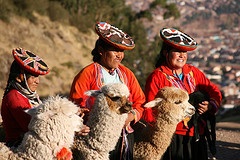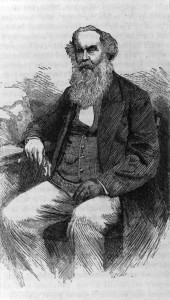Alpacas are South American members of the camelid family and come from the altiplano in the central-west region of the continent. As you might guess from the name, camelids include camels as well as llamas (animals not monks), vicunas and guacanos. The majority of alpacas in the world are in the Andean Highlands, mostly in Peru as well as Chile and Bolivia. As they are accustomed to freezing winters and mountains you can understand why our hairy little friends are much happier in cold conditions than hot ones. The Early Days Alpacas can trace their ancestry back a couple of million years and it is commonly agreed that they have been domesticated for about 6000 years. Recent DNA evidence shows that they are direct descendants of the wild vicuna and their genus name was changed from lama pacos to vicugna pacos to reflect this. Alpacas were highly prized by the Incas and allotted almost magical status. Too small to be pack animals or to be ridden, the alpaca was kept mainly for its fibre – which has wonderful warmth and softness – but also for sacrifices and for meat. Their fibre was considered the fibre of the gods and many beautiful textiles have been found dating back to that era. Alpaca breeding was controlled by Inca royalty who developed husbandry and colour programmes. Two distinct types emerged, the huacaya and the suri. (The huacaya is the fuzzier teddy-bear looking one, while the suri has long silky ringlets.) The Inca people traded and bartered using alpaca goods and wealth was judged on how many alpacas you owned. After the European “Conquest” (i.e. massacre and genocide) of Peru in the 16th century the ten million indigenous inhabitants were decimated, the alpacas massacred and the textiles burned. Just one million natives surviving by moving to higher ground, taking their remaining alpacas with them. What Happened Next As you can imagine, life was tough for the native Andean people in the harsh mountainous conditions. They survived at subsistence level and any selective breeding programmes and husbandry used by the Incas was abandoned in favour of staying alive. And so it continued for the next 450 years.
In the mid 19th century, towards the end of England’s Industrial Revolution, manufacturer Sir Titus Salt discovered bales of alpaca fibre in a warehouse in Liverpool and went on to create a luxury cloth he called “the other Inca gold” – alpaca. He sent some to the royal family and in short, it was all a huge success. He created a mill, modestly called Saltaire, dedicated exclusively to producing the shimmery, soft fabric. Problems in Peru English spinning mills were eventually set up in 1945 in Arequipa, now known as “the alpaca centre” of Peru, firmly establishing alpaca as a luxury fibre. Gradually the Peruvian government took steps to encourage programmes to improve alpaca breeding and re-establish the industry, but in 1969 a military coup changed everything. Land was confiscated and returned to peasants who lacked the skills to manage large herds. That, coupled with drought and the activities of the Shining Path terrorist group, meant that by 1990 there had been a 50% drop in the alpaca population. Alpaca Export To try and build up the herds again and provide income for farmers, the governments of Peru, Chile and Bolivia agreed to lower their export restrictions. Alpacas were exported to the USA, Canada, Australia, New Zealand and the UK. Breeders in these countries now had the opportunity to invest in these lovely creatures and to work on improving the fibre and establish their own native herds. The USA stopped importing alpacas in 1998 to preserve the existing national herd.
Gli alpaca sono membri sudamericani della famiglia dei camelidi e provengono dall’altopiano della regione centro-occidentale del continente. Come avrete intuito dal nome, i camelidi comprendono i cammelli così come i lama ( gli animali non i monaci), le vigogne e i guanaco. La maggior parte degli alpaca nel mondo si trovano sulle regioni montuose andine, per lo più in Perù così come in Cile ed in Bolivia. Dato che sono abituati ad inverni ghiacciati e alle montagne capirete perchè i nostri piccoli amici pelosi sono molto più felici nei climi freddi piuttosto che in quelli caldi. Le Origini Gli alpaca possono ricondurre i loro antenati a circa un paio di milioni di anni fa ed è opinione comune che questi siano stati addomesticati da circa 6000 anni. Recenti prove basate sul Dna mostrano che sono discendenti diretti della vigogna selvatica ed il loro nome scientifico è stato cambiato da lama pacos in vigugnapacos per riflettere tale scoperta.
Gli alpaca erano altamente apprezzati dagli Inca e veniva loro attribuito uno status quasi magico. Troppo piccoli come animali da lavoro o per essere cavalcati, gli alpaca venivano allevati principalmente per la loro lana – straordinariamente calda e soffice – ma anche per i sacrifici e per la carne. La loro lana era considerata la fibra degli dei e sono stati ritrovati moltissimi tessuti risalenti a tale epoca. L’allevamento degli alpaca era controllato dai regnanti Inca che ne svilupparono la zootecnica ed i vari colori. Nacquero due tipologie distinte, gli huacaya ed i suri. (l’ huacaya è il tipo più lanuginoso che somiglia ad un orsetto di pelouche, mentre il suri ha dei lunghi boccoli setosi.) Gli Inca conducevano scambi commerciali e baratti usando beni derivanti dall’alpaca e la ricchezza veniva giudicata in base a quanti alpaca si possedevano. Dopo la “Conquista” europea (ovvero massacro e genocidio) del Perù nel 16º secolo i 10 milioni di abitanti indigeni vennero sterminati, gli alpaca massacrati e i tessuti bruciati. Solo un milione di nativi sopravvissero spostandosi verso terreni più elevati, portando con loro gli alpaca rimanenti. Cos’è Successo Dopo Come potete immaginare, la vita era dura per i nativi andini nel bel mezzo del rigido clima montuoso. Riuscirono a sopravvivere ad un livello di sussistenza ed ogni programma di allevamento selettivo e di zootecnica utilizzato dagli Inca fu abbandonato in favore della mera sopravvivenza. E la cosa andò avanti per i successivi 450 anni.
Nella metà del 19º secolo, verso la fine della Rivoluzione Industriale Inglese, il produttore Sir Titus Salt scoprì delle balle di lana di alpaca in un magazzino a Liverpool e creò un tessuto di lusso che chiamò “l’altro oro degli Inca” – alpaca. Ne inviò un po’ alla famiglia reale e in breve, divenne un enorme successo. Creò una filanda, chiamato in maniera modesta Saltaire, dedicata esclusivamente alla produzione dello scintillante, soffice tessuto. Problemi in Peru Vennero alla fine creati dei lanifici inglesi nel 1945 ad Arequipa, ora nota come “il centro alpaca” del Perù, imponendo stabilmente l’alpaca come lana di lusso. Gradualmente il governo peruvianofece dei passi per incoraggiare i programmi atti a migliorare l’allevamento dell’alpaca e a ristabilire l’industria, ma nel 1969 un golpe militare cambio tutto quanto. Le terre vennero confiscate e restituite ai contadini che non avevano le nozioni necessarie a gestire grosse greggi. Questo, assieme alla siccità ed alle attività del gruppo terrorista comunista Sendero Luminoso, ebbe come risultato che nel 1990 La popolazione di alpaca aveva subito un calo del 50%. Esportazione di Alpaca Per provare a riformare nuovamente le greggi, i governi di Perù, Cile e Bolivia acconsentirono ad abbassare le loro restrizioni relative all’esportazione. Vennero esportati alpaca negli Stati Uniti, Canada, Australia, Nuova Zelanda e Regno Unito. Gli allevatori di queste nazioni avevano ora l’opportunità di investire su queste adorabili creature e di lavorare per migliorare la lana e per stabilire le loro greggi native. Gli Stati Uniti fermarono l’importazione alpaca nel 1998 per preservare le greggi nazionali esistenti.


